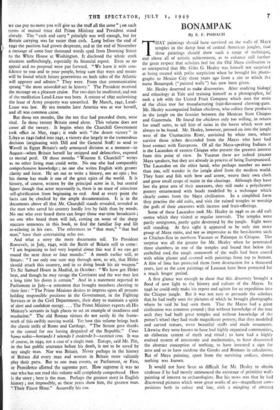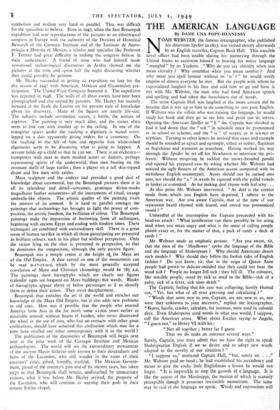BONAMPAK
By E. F. PODACH
THAT paintings should have survived on the walls of Maya; temples in the damp heat of central American jungles, that these paintings should show such a range of technique, and above all of artistic achievement, as to enhance still further the great respect that scholars feel for the Old Maya civilisation is so unexpected that Mr. Giles G. Healey was himself not surprised at being treated with polite scepticism when he brought his photo- graphs to Mexico City three years ago from a site to which the name Bonampak (" painted walls ") has now been given.
Mr. Healey deserved to make discoveries. After studying biology` and ethnology at Yale and training himself as a photographer, he' took a job with the United Fruit Company which uses the resin of the chico tree for manufacturing fruit-flavoured chewing-gum.
Mr. Healey accompanied Indian chicleros, who collect these products in the jungle on the frontier between the Mexican State Chiapas and Guatemala. He found the chicleros only too willing, in return for small sums, to tell him of ruins in the forest which were not always to be found. Mr. Healey, however, pressed on into the jungle west of the Usumacinta River, unvisited by white men, where survive those tribes descended from the Mayas who have had least contact with Europeans. Of all the Maya-speaking Indians it is the Lacandon of eastern Chiapas who present the greatest interest from this point of view. In Yucatan there are indeed 320,000 Maya speakers, but they are already in process of being Europeanised. The Lacandon on the other hand, who perhaps number no more than 200, still wander in the jungle aloof from the modern world. They hunt and fish with bow and arrow, weave their own cloth and grow small crops of maize in the clearings. Although they have lost the great arts of their ancestors, they still make a polychrome pottery ornamented with heads modelled by a technique which clearly comes from the Maya civilisation. In a simplified form they practise the old cults, and visit the ruined temples to worship the gods of their ancestors with incense and fruit-offerings.
Some of these Lacandon took Mr. Healey in 1946 to an old cult centre which they visited at regular intervals. The temples were partly overgrown, partly quite destroyed by the jungle. Eight were still standing. At first sight it appeared to be only one more group of Maya ruins, and not so impressive as the best-known such as Chichen-Itza in northern Yucatan or Palanque in Chiapas. The surprise was all the greater for Mr. Healey when he penetrated three chambers in one of the temples and found that below the corbelled roof.- the rough stonework of the walls had been coated with white plaster and covered with paintings from top to bottom. A film of lime has protected them from destruction for a thousand years, just as the cave paintings of Lascaux have been protected for a much longer period.
A first glance was enough to show that this discovery brought a flood of new light to the history and culture of the Mayas. In 1946 he could only make his report and agitate for an expedition into the Chiapas jungle. But it was not easy to persuade the scholars that,he had really seen the pictures of which he brought photographs where he said he had seen them. That the Mayas had a great civilisation was common ground ; that without knowledge of the true arch they had built great temples and without knowledge of the potter's wheel they had made magnificent pottery; that they modelled and carved statues, wove beautiful stuffs and made ornaments. Likewise they were known to have had highly organised communities, an elaborate system of myth and ritual ; to have had a highly evolved system of astronomy and mathematics, to have discovered the abstract conception of nothing, to have invented a sign for zero and so to have outdone the Greeks and Romans in calculation. But of Maya painting, apart from the surviving codices, almost nothing was known.
It would not have been so difficult for Mr. Healey to obtain credence if he had merely announced the existence of primitive wall- painting of interest to archaeologists. But his news was that he had discovered pictures which were great works of art—magnificent com- positions both in colour and line, with a mingling of abstract symbolism and realism very hard to parallel. That was difficult for the specialists to believe. Even in 1947, when the first Bonampak expedition had sent reproductions of the pictures to an ethnological congress in Europe with the authority of the Division of Historical Research of the Carnegie Institute and of the Instituto de Antro- pologia a Historia of Mexico, a scholar and specialist like Professor F. Termer had great difficulty in making the congress believe in their authenticity. A friend of mine who had himself made sensational archaeological discoveries in Arabia showed me the pictures at the time and spent half the night discussing whether they could possibly be genuine.
Mr. Healey succeeded in getting an expedition on foot for the dry season of 1947 with American, Mexican and Guatemalan par- ticipation. The United Fruit Company financed it. The expedition was repeated in 1948. The walls of all three rooms have now been • photographed and also copied by painters. Mr. Healey has recently lectured at the Ecole du Louvre on the present state of knowledge about his discovery. Many of the figures are nearly life-size. The subjects include ceremonial scenes, a battle, the torture of captives. The painting is very much alive, and the scenes often seem to link one with another up to the ceiling. In one of the triangular spaces under the vaulting a dignitary is seated cross- legged on a dais apparently giving orders for a ceremony. On the vaulting to the left of him and opposite him white-robed dignitaries seem to be discussing what is going to happen. A servant holds up a child so that he can see. There is an orchestra— trumpeters with next to them masked actors or dancers, perhaps representing spirits of the underworld, then men beating on the resonant shells of large turtles ; then a player on a tall skin-topped drum and five men with rattles.
Maya sculpture and the codices had provided a good deal of knowledge about ceremonial, but the Bonampak pictures show it in all its splendour and detail—costumes, grotesque divine-masks magnificent feather ornaments—all the instruments of ritual, strange umbrella-like objects. The artistic quality of the painting rivals the interest of its content. It is hard to parallel amongst the paintings that archaeology has brought to light the power of com- position, the artistic freedom, the brilliance of colour. The Bonampak paintings make the impression of borrowing from all techniques, beginning with ancient Egypt and ending with modern times. These techniques are combined with extraordinary skill. There is a great scene of human sacrifice in which all those participating are presented in brilliant colours, each in his place but without perspective. Only the victim lying on the altar is presented in perspective, so that he dominates the composition, although the only passive figure.
Bonampak was a temple centre at the height of, the Maya art of the Old Empire. A date carved on one of the monuments can be read 9-17-15-0-0, which by the most generally accepted correlation of Maya and Christian chronology would be 785 A.D. The paintings show hieroglyphs which are clearly not figures (calendar signs are frequent on Maya buildings) but words. Blocks of hieroglyphs appear above or below personages as if to identify them or define their action. They await decipherment.
Bonampak thus enriches the art of the world and enriches our knowledge of the Maya Old Empire, but it also adds new problems to old ones. How was it possible that the people who entered America from Asia in the far north some 12,000 years earlier as miserable nomads without beasts of burden, who never discovered the wheel or the use of iron, who had no contacts with other great civilisations, should have achieved this civilisation which may for a time have rivalled any other contemporary with it in the world ? The publication of the discoveries of Bonampak will begin next year as the joint work of the Carnegie Institute and Mexican archaeologists. The world will see the extraordinary monuments of the ancient Mayas hitherto only known to their descendants and heirs of the Lacandon, who still wander in the ruins of their ancestors' cities, gifted, friendly, truthful. The Mexican Govern- ment, proud of the country's past and of its ancient races, has taken steps so that Bonampak shall remain, undisturbed by unnecessary visitors, what it was before Mr. Healey arrived, the property of the Lacandon, who will continue to worship their gods in their remote Sistine chapel.







































 Previous page
Previous page